Laura and I went to Bolivia for part of our honeymoon. It is telling of our unremarkable culinary experience that I can't find any representative photos of the food there, but we did take our favorite photo ever at the Salar de Uyuni, the world's largest salt flat:
The one food that we do remember distinctly is pique macho, which is essentially meat and hot dogs on top of french fries. But that would require frying. Again. Much as I wanted to explore some native foods, it became clear through my research that this really is the most popular distinctive Bolivian dish, found everywhere from the tropical lowlands near Brazil to the Andean towns bordering Peru. So I bit the bullet and bought a deep fryer. Deep-frying is not a tool in my standard cooking arsenal, but too many of these international cuisines call for it, and stovetop frying is messy, difficult, and time-consuming.
We had a record indoor crowd of 11. Noshing regulars Caroline, Kirsty, Dan, and Raven were on hand, as well as our friends Raber and Clara in from Boston, Nick and Miriam (all four of whom went to UChicago with me), and Jeremy. The meal was a rare mid-afternoon one so Raber and Clara could drive back home! And big props to Kirsty for helping a lot in the kitchen, including spud-bashing (apparently that's British slang for peeling potatoes) and dish-washing (I'm sure there's some great slang for that too.)
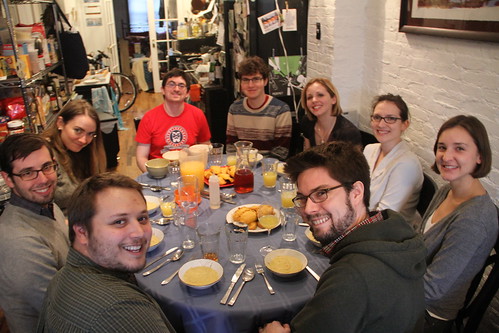
Yungueño | Brandy with orange juice
The alcohol we encountered in Bolivia was either weak beer or sub-par wine, but apparently the national liquor is singani, a grape brandy similar to Peru's pisco, which is the best we could do without much scouring. We mixed it up with orange juice and simple syrup for a tasty drink.
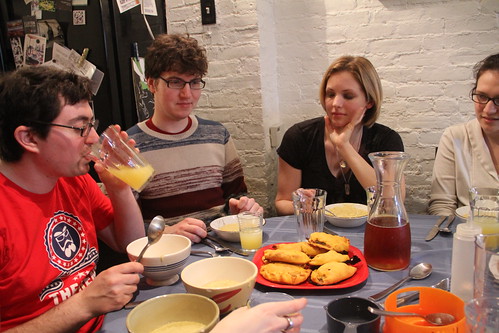
Salteñas | Savory stuffed pastries | Recipe
The street food de rigeur in Bolivia is the salteña. (Oddly, named after a city in Argentina; Wikipedia's got the scoop.) It's a two-day preparation, as the filling is prepared with gelatin to make for a moist filling without making the crust soggy. And what makes that crust yellow? Annatto seeds, known in Spanish as achiote despite "annatto" sounding plenty Spanish to my ears. Anyway, you heat the seeds in shortening to release the color. The dough, which contained a pound (yeesh) of Crisco, was nice and easy to work with. The recipe calls for beef; I also kind of improvised a vegetarian version (sans gelatin, of course) with potatoes, peas, and onions. I was really happy with how they turned out.

Lagua de choclo | Andean corn soup | Recipe (in Spanish — I omitted the meat)
Choclo is a type of corn with really big, fat kernels. You can do a lot with it, for example the Incas found out that you can chew it, spit it out, and let it ferment into a type of beer called chicha. We didn't quite do that, instead I took frozen kernels, ground the, in the food processor, and made a stew with bouillon and some root vegetables, finished off with the immersion blender to make it smooth. Filling and mildly flavored, like so much of Andean cuisine.
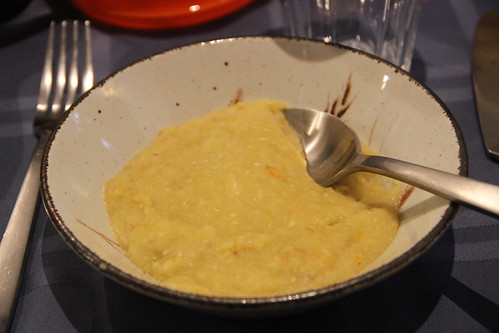
Pique macho | Fries with beef and hot dogs | Recipe (in Spanish)
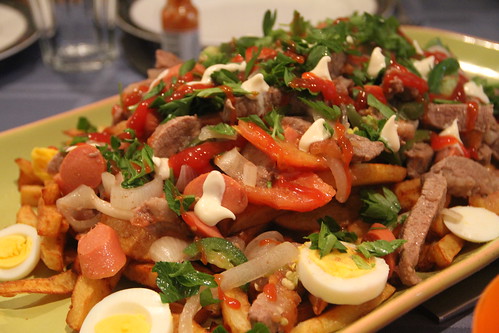
So named because apparently, to finish off a heaping plate of this is evidence of machismo. Turned out just about how I remembered it, with mildly overcooked strips of beef, hot dogs that kind of bridge the texture gap between beef and french fry, and the Monet-like points of mayonnaise and Pollock-like swathes of ketchup coexisting on a meaty canvas. (To be fair, though, in a few restaurants we had the option to have llama instead of beef.)
Pastel de quinua y chocolate | Quinoa chocolate cake | Recipe
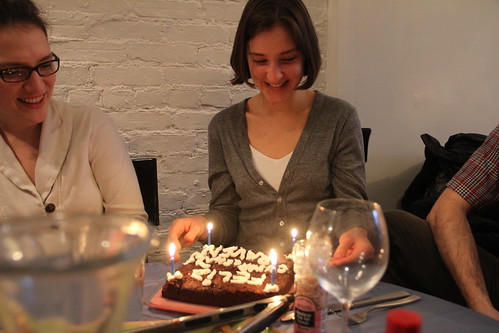
Bolivians (where, I'm eager to point out apropos of nothing, the currency is the uncreatively-named yet annoying-to-say-all-five-syllables Boliviano) aren't much for sweets, but Dan gave me the heads-up that Raven's birthday was around the corner so I had to do something. You also might be thinking, "Bolivia? Isn't that where quinoa comes from?" It's true, but in recent years so much of their crop has been exported to fat-walleted countries that this native, highly nutritious grain now costs a lot more than other staples. (I think the only time we ate quinoa when we were there was part of the package lunch out on the salt flats, incidentally.)
Anyway, in homage to this wondergrain, I baked this brownie-like cake the likes of which have probably never actually been seen on un plato boliviano (that's "Bolivian" as an adjective, not the money. See? So confusing). I winged it twice on the recipe: I used King Arthur Flour's Fior di Sicilia in place of half of the vanilla for a luscious orange accent, and since no baking powder measure was given I improvised with a teaspoon and a half and probably should have done a bit more. I thought it was quite nice and finished my piece, but not everyone finished theirs, so maybe the texture was too dense, the orange a bit too strong, or their machismo spent on the main course.
Full disclosure time: King Arthur Flour (whose amazing people I had the pleasure to meet while filming a commercial starring them for Google) sent me the Fior di Sicilia at no cost. (Being a blogger has a few benefits!) I should also point out that the shipment included the 8 inch baking pan which was very nice; the recipe called for a springform pan which I don't have, but due to the corrugation of this square pan, it removed easily.
~~~
And that's a wrap! Next week we're back in the Balkans with Bosnia & Herzegovina. If it's anything like Albanian food, I know we're in for a treat.

